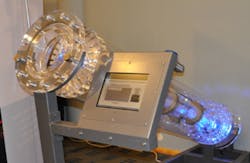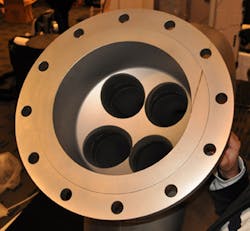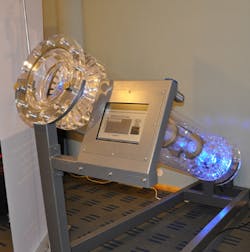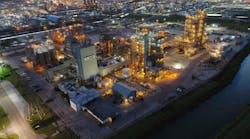Coriolis flowmeters were first introduced to the public by Micro Motion in 1977. This was more than 10 years after ultrasonic flowmeters were brought onto the market in Japan and around the same time as the introduction of vortex flowmeters and thermal flowmeters. In the years since, Coriolis flowmeters have competed in varying degrees with all these flowmeter types, although they have a number of features that give them an edge for many applications.
The operation of Coriolis flowmeters can be difficult to understand, partly because the sensor tubes are enclosed in a stainless steel or other metal tube. For many years, all Coriolis flowmeters contained one or two bent tubes that were caused to vibrate. The tubes deflect in response to the inertia of the fluid, and the meter uses this measured deflection to compute mass flow.
After Bent Tubes, Straight Tubes Provide a New Twist
While bent-tube Coriolis flowmeters have advantages over many traditional-technology meters, they do introduce pressure drop into the system. Pressure drop is an issue because in many cases the fluid has to be speeded up back to its original velocity. Another issue has to do with the tendency for build-up to occur around pipe curvatures. This can be especially problematic for sanitary applications. Having a bent pipe also slows down the fluid, making it more difficult to meter high-velocity fluids.
Suppliers responded to the drawbacks of the bent-tube design by producing straight-tube Coriolis flowmeters. Schlumberger was the first company to introduce a straight-tube design in 1993, but it withdrew this product after several months. KROHNE followed with the first commercially successful straight-tube meter in 1994.
Over the years, straight-tube Coriolis flowmeters have become increasingly popular, as they address the problem of pressure drop because the fluid does not have to travel around a bend. This makes the meter better able to handle high-velocity fluids, and straight-tube meters can be drained more easily, which is important for sanitary applications. Straight-tube Coriolis flowmeters also offer a more compact design than bent-tube meters, which can be quite large and unwieldy, especially in the larger line sizes.
Straight-tube flowmeters work on the same principle as bent-tube meters—the inertia of the fluid causes acceleration of fluid particles in the first half of the flowmeter and deceleration of fluid particles in the second half of the meter. This inertia generates a Coriolis force that slightly distorts the measuring tube. This distortion is detected by sensors and is proportional to mass flow. Because the oscillatory properties of the measuring tube vary with temperature, temperature is continuously measured so necessary adjustments can be made in the measurement device.
Larger Meters Designed for Energy Markets
More than any other meter, Coriolis flowmeters have line size limitations. Due to the nature of the technology, Coriolis flowmeters get large and unwieldy once they reach the 6-inch size. Even 2-inch, 3-inch, and 4-inch meters are quite large. The majority of Coriolis flowmeters sold are in the zero to 2-inch diameter ranges.
Suppliers have begun introducing large line size Coriolis meters. Rheonik, now a part of GE Measurement & Control Systems, was the first to do so. Rheonik put together two 6-inch Coriolis meters to create a meter that can handle larger line sizes. Other companies that have introduced Coriolis flowmeters for line sizes above 6 inches include Endress+Hauser, KROHNE, and Micro Motion. Endress+Hauser and Micro Motion have bent-tube meters, while KROHNE’s large line Coriolis flowmeters are straight tube, which are long, but less bulky than the bent-tube Coriolis flowmeters.
There is definitely a trend among Coriolis suppliers toward offering flowmeters for the larger line sizes. Currently, Coriolis flowmeters are available in 8-, 10-, 12-, and 14-inch line sizes. Endress+Hauser has even introduced a meter that will accommodate line sizes of 16 inches. Most of these meters are aimed at the custody transfer market for oil & gas applications.
Endress+Hauser’s most recent offering is the Proline ProMass 83S/84X, which is so far the largest Coriolis flowmeter made. Designed for a 14-inch line, it can be fitted with 12-, 14-, and 16-inch flanges to accommodate different line sizes. What is unique about the design of the ProMass 83X/84X is that it is a four-tube Coriolis flowmeter. The 84X is suitable for custody transfer applications.
All indications are that these large line size meters are selling quite well. Why are they doing so well, considering that their price tags are often in the range of $75,000? The answer has to do with the high value of the fluids they are measuring. Many of these meters are designed to go into the oil & gas industry. With oil selling at between $90 and $100 a barrel, the enhanced accuracy provided by Coriolis flowmeters can make a significant difference in the measurement of high-priced fluids. Coriolis flowmeters also offer high reliability and minimal maintenance, so their cost of ownership is less despite their high initial cost. Look for more large line size Coriolis flowmeters to be released as suppliers do more R&D.
Suppliers Continue to Make Technological Improvements
Suppliers have made a number of improvements in Coriolis technology over the past five years. Coriolis flowmeters are now much better able to measure gases than previously, and the majority of Coriolis suppliers now have meters that can measure gas flow. Straight-tube meters have become more accurate and reliable, thereby addressing some of the drawbacks of bent-tube meters. And both Micro Motion and Endress+Hauser have broken the price barrier, offering Coriolis flowmeters at a considerably reduced price point. Other improvements include:
- The use of stronger and lighter materials of construction like titanium that make the meters stronger and longer lasting.
- The introduction of self-diagnostic and advanced diagnostic features that improve performance and enhance reliability.
- Companies such as Foxboro/Invensys and others have made progress in using Coriolis flowmeters to measure two-phase flow.
- Special applications such as corrosive fluids have been addressed with more durable sensor tubes.
- Other Coriolis flowmeters have been built to withstand high pressures and high temperatures. Some of these meters are designed for OEM markets. Other special OEM applications include batch meters, compressed natural gas (CNG) meters, and meters for oil & gas applications.
Petroleum Liquid & Natural Gas Applications
The fastest growing application for petroleum liquids for Coriolis flowmeters is custody transfer, including upstream, mid-stream, and downstream applications. Many of the new large line size Coriolis flowmeters with line sizes from 8 to 14 inches are designed for custody transfer of petroleum liquids. Coriolis flowmeters are also displacing some positive-displacement flowmeters for applications involving downstream delivery of petroleum liquids. The market for LNG measurement is expected to grow as natural gas becomes a long-term alternative to coal, oil and nuclear energy. LNG is especially important in the Asia-Pacific region where many countries, such as Malaysia and Indonesia, are islands and need to import LNG in order to use natural gas as an energy source.
Custody transfer of natural gas is another fast growing application. This is due to increased demand for natural gas and also to higher natural gas prices, as energy prices continue on an upward slope. Compressed natural gas applications are also growing rapidly. Even though gas has traditionally been a more difficult measurement for Coriolis flowmeters, suppliers have made a lot of progress in this area.
High Accuracy & Reliability Are the Bottom Line
Despite their higher prices and line size limitations, Coriolis flowmeters have become very popular with suppliers and end-users alike. Coriolis is the most accurate flowmeter made, and its design gives it high reliability. In fact, the Coriolis flowmeter market has become the fastest growing of any flowmeter type with the possible exception of multiphase. The popularity of the new large line size meters is further enhancing revenue growth. And given that large line meters are aimed at the rapidly expanding oil & gas markets, Coriolis flowmeter growth can be expected to continue for the foreseeable future.
Jesse Yoder,
Ph.D., is president of Flow Research Inc. in Wakefield, Mass., a company he founded in 1998. He has 25 years of experience as an analyst and writer in process control. Dr. Yoder specializes in flowmeters and other field devices, including pressure and temperature products. Dr. Yoder can be reached at [email protected].
For more information on Flow Research’s work in the area of Coriolis Flow Measurement, visit www.flowcoriolis.com.
www.flowresearch.com





